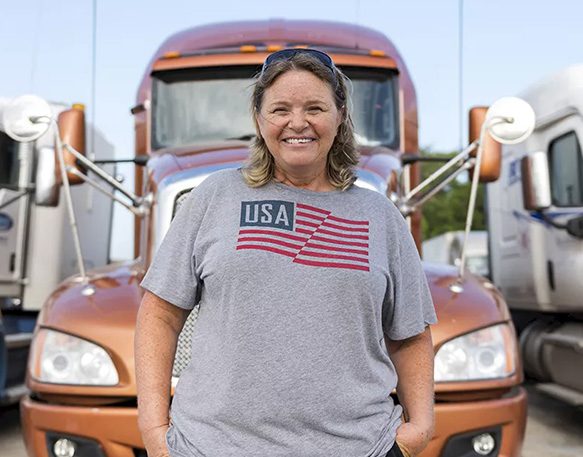For carriers and owner-operators, preparation is key. It can be the difference between major profit and barely breaking even. After all, being out on the road hauling loads can be a stressful affair, and if you’re trying to figure everything out while already behind the wheel, you can lose out on profits by hauling less efficiently than you could have otherwise.
That’s why truck route planning is essential for any trucking operation. Not only does it help you maximize your revenue, it also gives owner-operators peace of mind while they’re hauling loads and even allows them to spend less time driving. Let’s take a look at what truck route planning is, why it’s important, and how to do it properly to maximize both profits and efficiency.
What is truck route planning?
Truck route planning is the process through which carriers and owner-operators find the most efficient route for hauling loads from point A to point B. The average person might hear route planning and think of opening Google Maps or Waze to navigate them to their destination, but truck driver routes and truck route mapping are more complicated than that.
When engaging in truck route planning, carriers and owner-operators must keep many factors in mind beyond the most direct route between destinations. These include timescales for deliveries, vehicle sizes, road width and height restrictions, and more. Truckers are also under different constraints than your typical driver (like having limits on the number of hours they can spend behind the wheel), and following those specific regulations typically requires drivers to plan ahead. Doing so not only helps them be more efficient with their time, but also keeps them and other drivers on the road safe.
All of this ultimately means that carriers and owner-operators should know exactly what their travel plan is before they even start their engine. That way they can spend less time on the road and make the most of the time they do spend hauling loads.
In addition, because truck route mapping is much more complicated than its consumer counterpart, typically navigation apps won’t make the cut for truckers. For successful truck route mapping, it’s necessary for carriers and owner-operators to utilize a comprehensive truck route planning software that gives them all the features they need to make the process easy and painless.
Why is truck route planning important?
At a high level, truck route planning helps carriers and independent owner-operators operate with far greater efficiency and productivity, which translates directly into higher overall revenue.
Truck route planning specifically helps carriers and owner-operators cut down on two of their biggest expenses: fuel and maintenance costs. DAT estimates that fuel costs have gone from $0.52 per mile last year to $0.76 as of September 2022 — a 52% increase. With operating costs at $2.01 per mile, fuel makes up 38% of an owner-operator’s total expenses.
Repairs and maintenance consist of 6% of total costs at approximately $0.12 per mile. While fixed finance expenses and wages are an overall larger slice of the pie, rising maintenance costs shouldn’t be ignored. Plus, vehicle problems can often be unexpected, which leaves carriers and owner-operators unprepared for the financial setbacks that can spring up as a result of needing repairs. Less time on the road means less opportunity for such problems to arise. It also means less wear and tear on your vehicle to begin with.
Diving a little deeper, truck route planning also provides many quality-of-life changes and improvements that make processes easier for carriers and owner-operators to handle. For instance, truck route planning software can help you avoid congested areas, meaning you’ll spend less time stuck in traffic, simultaneously wasting less fuel since you’ll spend more time driving at a consistent speed and finishing your hauls more quickly.
Using truck route planning to spend less time on the road is not just good for owner-operators’ wellbeing, it also makes it easier to adhere to FMCSA regulations on driving limits, which include:
- Taking at least one 30 minute break when driving for more than 8 hours
- Not driving for more than 11 hours during any 14-hour window
- Not driving for more than 60 hours within a seven-day time window
Now that you know how truck route planning can improve your trucking business, let’s go over some helpful tips for how to properly implement truck route planning and start reaping its many benefits.
Tips for truck route mapping
- Have directions, stops, and breaks prepared ahead of time. Truck drivers who only stop when they need gas or are inconsistent with when they take their breaks are losing out on efficiency and valuable time. Truck route planning is all about thinking ahead: directions should be loaded up on the GPS, you should know exactly which service stations you’ll stop at, and which routes you’ll take from point A to point B. The bottom line is that when you’re on the road, there should be no point where you have to figure things out on the fly.
- Inspect your truck before departing. Inspecting your truck before you head out to haul a load is a preventative measure that is guaranteed to save you from unexpected financial headaches down the line. Perhaps you’ll find that you need maintenance or repairs that would have otherwise caused issues on the road. Maybe you’ll see that you don’t have enough fuel to get to your first planned stop and have to add a pitstop to your route. Breakdowns and other delays lose you time, money, and can even risk your safety and the safety of other drivers on the road — which is why inspection is one of the most essential habits for drivers and owner-operators to develop.
- Prep for the unexpected. Even with a truck driver route all mapped out, there are cases where the unexpected happens. That’s why it doesn’t hurt for owner-operators to prepare for emergencies by looking up repair shops or service stations along their route that they’ll be able to access easily. In case of a breakdown, it’s vital to know where you can turn for assistance. Prepping for an emergency also means bringing extra supplies with you, such as a change of clothes, non-perishable food, and a first-aid kit, among other things. Owner-operators should create a checklist of sorts with all the items they need before they depart. That way, when emergencies arise, you’ll know exactly what to do and how to act fast.
- Monitor the weather. A simple yet vital tip for truck route planning, owner-operators can lose out on valuable hauling time if they get caught in rain, snow, or other bad weather conditions. Bad weather won’t just cause delays, it can lead to traffic accidents, damaged equipment, or cause excessive wear on your vehicle. Looking ahead at the forecast along your route will help you make decisions like whether to re-route the load or re-schedule it for another time.
- Maintain communication with other parties. When you’re delivering a load for a shipper or broker, it’s important to keep them in the loop. Typically, truck route planning software allows other parties to track shipments via live GPS or ELD registration, so as long as things are going according to schedule, they’ll be able to see it. However, if a problem arises, say, for instance, the load’s contents are damaged or the truck is delayed, open communication will help you manage the situation calmly and successfully. Whether you’re delivering good news or bad news, carriers and owner-operators should plan to inform other parties of any updates on freight deliveries as part of their standard process.
DAT is your one stop shop for truck route planning software
In this day and age no carrier or owner-operator should be relying on manual planning to boost efficiency. Picking the best tools and truck route planning software will help trucking companies reach greater levels of efficiency and productivity than ever before.
Before anything else can happen, truck route planning has to begin with finding the loads that best fit your trucking business. The best way to do that is with the DAT Load Board. With DAT, you can gain access to more than 267 million loads posted annually and view data like current truckload rates and market conditions to ensure that you’re hauling the right loads for the right price.
A load board subscription also gives you access to the DAT One Mobile App, which gives you a wide variety of features and solutions that assist with truck route planning. Whether you’ll need to find truck stops, gas stations, weigh stations, or anything else, DAT gives you the power to plan your truck route in the palm of your hand.
TriHaul is another feature that helps with truck route mapping by enabling owner-operators to turn a roundtrip into a triangular route by taking on an extra load, which reduces your deadhead miles and nets you a higher profit than if you had just gone straight to your destination and back. This can help supercharge your truck route planning process and bring even greater efficiency to your business.
For truck route planning and beyond, DAT’s carrier services provide you with everything you need to make sure your trucking business is running as smoothly as possible. Solutions like freight rate analytics, factoring, and fuel card programs can all help you make the best decisions on which loads to haul and the best way to haul them. Owner-operators seeking effective truck route planning software need look no further than DAT!
Simplify truck route planning with DAT!
Ready to save time and money when it comes to truck route planning? Use DAT’s tools! From TriHaul to the DAT load board, we have everything you need to plan efficient truck driver routes.
Take advantage of DAT’s carrier services today to make truck route planning a breeze!




